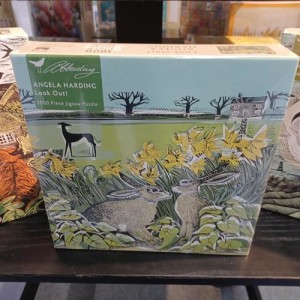I am very pleased to be writing my latest Licensing Lookout on the way back from a very enjoyable three days at the Spring Fair in Birmingham.
There were lots of positives through the week – a high step count, great meetings, smiling faces and conversations that were looking forward rather than back. Of course, we can’t ignore the challenges we are all facing and the fact that business has changed, but it was very encouraging to hear a lot of optimism from licensees. Indeed my last licensee conversation was with a leading licensee who said the show had been fantastic and that his company had been writing orders throughout the show. Fingers crossed this trend continues.
I was also delighted to be a judge for the Gift of the Year awards this year. Judging took place on Wednesday (9 February) at the show and it was a really great experience. I enjoyed reviewing all the shortlisted entries and chatting to fellow judges. A few recurring themes that I noticed across the entries were a greater awareness of sustainability in regards to product development – manufacturers are seemingly more tuned into the topic and are making efforts to ‘do the right thing’ were they can.
I also thought there was a lot of great examples of manufacturers looking to add value into products, building additional consumer appeal and a growing awareness among manufacturers of the value of social media in building a relationship with consumers to help sell product.
Encouragingly there was good representation from licensing in the entries and the licensed products more than held their own. I also felt that in some categories there was scope for licensing to play a greater role. At a general level I spoke to a few companies at the show who had a pre-set view on licensing, often saying it was too difficult or too expensive. I think there is some work to be done to educate and reassure licensing ‘prospects’ that their preconceptions may be wrong.
In terms of the wider show my unscientific analysis was that there was a little less licensing on show, which may be a reflection that the show was smaller than previous shows and that some licensees weren’t exhibiting this time round.
That said there were still some noteworthy examples of licensing for a Lookout to take note of and here are my top ten observations:
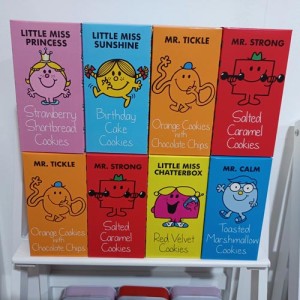 Food and drink are firmly established as gift categories and it is good to see the dedicated food gifting area thriving. There was a lot of interesting product on show across categories like popcorn, chocolate, biscuits, alcohol and confectionery.
Food and drink are firmly established as gift categories and it is good to see the dedicated food gifting area thriving. There was a lot of interesting product on show across categories like popcorn, chocolate, biscuits, alcohol and confectionery.
A licensing highlight were the ranges presented by Infinity Brands. These include Mr Men, Friends and Frida Kahlo. Mr Men is a long standing licence for the company and it has refreshed the packaging on this. Friends seems to be working well in gifting generally and Infinity has tapped into the brand well with products such as biscuits and naturally coffee related products.
I liked the art style used for the Friends and Mr Men products that made a nod to pop vinyls. Infinity’s use of Frida Kahlo was a further reminder of the growing strength of art licensing and how it can be a valuable tool in the gift sector.
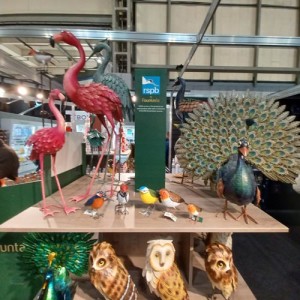 I noticed quite a few examples of cause related licensed ranges.
I noticed quite a few examples of cause related licensed ranges.
One of the finalists in the Gift of the Year was a range of Battersea Cats and Dogs Home cards, while I noticed licensees Fountasia (pictured right) and Primus were both working with the RSPB.
Such partnerships build credibility and help with consumer engagement. I would imagine for retailers in categories like garden centres, a well designed range that features a suitable charity is quite compelling and creates a good point of difference.
A recurring feature throughout the show were products developed featuring artwork from artists and illustrators. Art licensing is a strong component of Spring Fair most notably in greetings cards, but there were some other noteworthy examples.
Yorkshire-based artist Julie Dodsworth had products with Puckator and Kingfisher Cards. Julie was at the show and on hand to work with the licensees. This is an added bonus of working with artists – they can become part of the sales process and, of course, are also available to develop bespoke artwork to respond to trends. There seems to be an increasing trend for artists to manage their own licensed ranges alongside products they create and sell themselves. This is something Julie does and at the show artist Meg Hawkins had her own stand which featured a mix of licensed and own brand products.
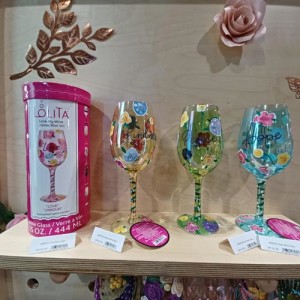 It is also encouraging to see global licensees such as Enesco use art licensing. Enesco used Spring Fair as an opportunity to launch a lovely range of decorated wine glasses featuring designs by artist Lolita. The glasses featured bright and bold colourful designs. They had the look of being hand decorated.
It is also encouraging to see global licensees such as Enesco use art licensing. Enesco used Spring Fair as an opportunity to launch a lovely range of decorated wine glasses featuring designs by artist Lolita. The glasses featured bright and bold colourful designs. They had the look of being hand decorated.
It is a real vote of confidence for art licensing to see a major player like Enesco launch a range like this at a major show and to give it such a prominent display on its stand. Of course, artists like Lolita are a way of Enesco tapping into new trends and contemporary styles. I imagine it sense checks demand and interest from their retailers looking. A further attraction of working with artists is they have the ability to engage with consumers through social media, trade interviews and PR.
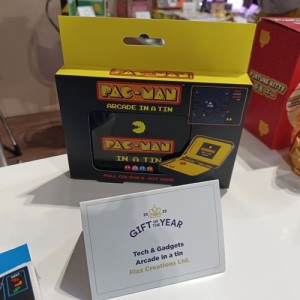 Gaming based product ranges were another recurring theme of the show further confirming the growing attraction to licensees and retailers of gaming properties.
Gaming based product ranges were another recurring theme of the show further confirming the growing attraction to licensees and retailers of gaming properties.
Gaming featured in the Gift of the Year nominations with Fizz Creations’ Arcade in a Tin products being a finalist in Tech and Gadgets category. Featuring Pac-Man, the product was a small sized full colour 8-bit game housed in a branded tin. It is a neat concept and a good use of a brand that will resonate with older consumers. There is definitely a growing interest in gaming brands that have an appeal to older consumers.
Puckator had a sizeable range of Pac-Man products and licensees have recognised that there is potential for gaming related giftware targeting older consumers.
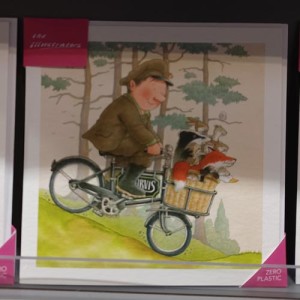 Classic characters are certainly in favour. Licensees such as Half Moon Bay feature characters like Wallace & Gromit, while Museums & Galleries’ Illustrators range seems to be thriving with characters such as Percy the Park Keeper (pictured left) and Paddington featuring.
Classic characters are certainly in favour. Licensees such as Half Moon Bay feature characters like Wallace & Gromit, while Museums & Galleries’ Illustrators range seems to be thriving with characters such as Percy the Park Keeper (pictured left) and Paddington featuring.
Peter Rabbit was a property that popped up on lots of stands. Classic characters offer licensees and retailers a predictable trajectory with well defined audiences.
Licensors which own classic characters have also got better at bringing in new design treatments and opening up new categories.
 I also observed that licensees and rights owners seem to be getting better at developing licensed products that are targeting specific audiences or occasions. It is no longer one size fits all in design terms and thought is being given to matching up artwork with specific end use.
I also observed that licensees and rights owners seem to be getting better at developing licensed products that are targeting specific audiences or occasions. It is no longer one size fits all in design terms and thought is being given to matching up artwork with specific end use.
A great example of this was a Snoopy greeting card on Hype Associates stand (pictured right). It featured a thought bubble saying ‘Here’s Joe Cool hanging around the student union’.
Not surprisingly this performs well in student towns.
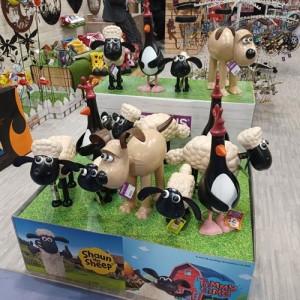 It was also good to see great examples of long-term licensing partnerships thriving.
It was also good to see great examples of long-term licensing partnerships thriving.
There seems to be a growing recognition that there is enduring value in nurturing long-term partnerships rather than chopping and changing partners.
This works well for all parties and can encourage licensees to be more inclined to invest in complex NPD.
In my own experience, I saw this with Half Moon Bay and Primus’ (pictured left) Aardman ranges. They have invested in new products and built their ranges out.
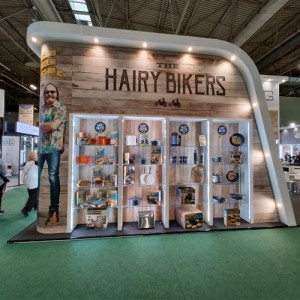 Personality brands had a presence in the kitchenware and homewares aisles, with The Hairy Bikers and Mary Berry both having prominent ranges. Indeed it was impossible not to notice the Hairy Bikers as they featured at supersize on one stand towering over the aisle (pictured right).
Personality brands had a presence in the kitchenware and homewares aisles, with The Hairy Bikers and Mary Berry both having prominent ranges. Indeed it was impossible not to notice the Hairy Bikers as they featured at supersize on one stand towering over the aisle (pictured right).
Heritage brands also featured and Spring Fair was a welcome opportunity for specialist suppliers like Fox & Chave to prove their credentials. Licensees like Fox & Chave work with a broad church of heritage brands and spend time nurturing relationships across the sector. Heritage organisations regard them as a trusted supplier which knows how to work with them and their assets.
I particularly loved Fox & Chave’s tie wall. Great way of showcasing the product.
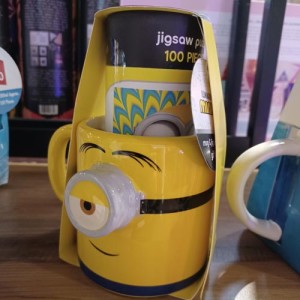 Returning to the Gift of the Year, it was good to see some of the creative thinking going into licensing – a good example was Fizz Creations’ licensed mugs which are co-packed with jigsaw puzzles. A nice combination which is neatly packed.
Returning to the Gift of the Year, it was good to see some of the creative thinking going into licensing – a good example was Fizz Creations’ licensed mugs which are co-packed with jigsaw puzzles. A nice combination which is neatly packed.
Licensing can’t stand still and it is good to see licensees using licences in tandem with new ideas and formats. It will be great to find out the outcome of the Gift of the Year judging. It was a lot of fun, but also quite a challenge as the standard was so high.
Based on the finalists, I think the gift industry is certainly in a good place in terms of the quality of gift products.
Ian Downes runs Start Licensing, an independent brand licensing agency. His Twitter handle is @startlicensing – he would welcome your suggestions for what to look out for.








